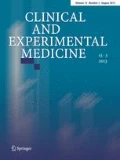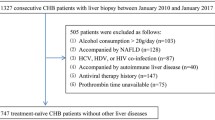Abstract
The globulin–platelet model (GP) is a new noninvasive liver fibrosis model developed in chronic hepatitis B (CHB) patients. This study aimed to evaluate the diagnostic performance of GP model for liver fibrosis and cirrhosis in CHB patients with high HBV DNA and mildly elevated alanine transaminase (ALT) levels. We enrolled 316 CHB patients with HBV DNA ≥ 4 log 10 copies/mL and 40 IU/L < ALT ≤ 80 IU/L. The GP, aspartate transaminase-to-platelet ratio index (APRI) and fibrosis index based on four factors (FIB-4) were calculated. Using liver histology as a gold standard, the diagnostic performances of noninvasive fibrosis models were compared by the area under receiver operating characteristic curves (AUROCs). Of 316 patients, 146 (46.2%), 64 (20.3%) and 40 (12.7%) were classified as having significant fibrosis, severe fibrosis and cirrhosis, respectively. To predict significant fibrosis, the AUROC of GP was lower than APRI (0.64 vs 0.76, p < 0.001) and equivalent to FIB-4 (0.64 vs 0.66, p = 0.366). To predict severe fibrosis, the AUROC of GP was equivalent to APRI (0.82 vs 0.79, p = 0.409) and FIB-4 (0.82 vs 0.77, p = 0.224). To predict cirrhosis, the AUROC of GP was higher than APRI (0.91 vs 0.84, p = 0.033) and FIB-4 (0.91 vs 0.80, p = 0.004). GP is a more accurate noninvasive fibrosis model than APRI and FIB-4 to diagnose cirrhosis in CHB patients with high HBV DNA and mildly elevated ALT levels. The clinical application of GP model may reduce the need for liver biopsy in CHB patients.


Similar content being viewed by others
References
Inoue T, Tanaka Y. Hepatitis B virus and its sexually transmitted infection—an update. Microb Cell. 2016;3(9):420–37.
Lin J, Wu JF, Zhang Q, Zhang HW, Cao GW. Virus-related liver cirrhosis: molecular basis and therapeutic options. World J Gastroenterol. 2014;20(21):6457–69.
Li ZQ, Hu CL, Yu P, et al. The development of hepatocarcinoma after long-term antivirus treatment of Chinese patients with chronic hepatitis B virus infection: Incidence, long-term outcomes and predictive factors. Clin Res Hepatol Gastroenterol. 2017;41(3):311–8.
Terrault NA, Bzowej NH, Chang KM, Hwang JP, Jonas MM, Murad MH. AASLD guidelines for treatment of chronic hepatitis B. Hepatology. 2016;63(1):261–83.
Shah ND, Sasatomi E, Baron TH. Endoscopic ultrasound-guided parenchymal liver biopsy: single center experience of a new dedicated core needle. Clin Gastroenterol Hepatol. 2017;15(5):784–6.
Yu JH, Lee JI. Current role of transient elastography in the management of chronic hepatitis B patients. Ultrasonography. 2017;36(2):86–94.
Guidelines for the prevention, care and treatment of persons with chronic hepatitis B infection. Geneva: World Health Organization; 2015.
Liu XD, Wu JL, Liang J, Zhang T, Sheng QS. Globulin–platelet model predicts minimal fibrosis and cirrhosis in chronic hepatitis B virus infected patients. World J Gastroenterol. 2012;18(22):2784–92.
Coskun BD, Altinkaya E, Sevinc E, et al. The diagnostic value of a globulin/platelet model for evaluating liver fibrosis in chronic hepatitis B patients. Rev Esp Enferm Dig. 2015;107(12):740–4.
Sarin SK, Kumar M, Lau GK, et al. Asian-Pacific clinical practice guidelines on the management of hepatitis B: a 2015 update. Hepatol Int. 2016;10(1):1–98.
Bedossa P, Poynard T. An algorithm for the grading of activity in chronic hepatitis C. The METAVIR Cooperative Study Group. Hepatology. 1996;24(2):289–93.
Albeck MJ, Borgesen SE. ROC-curve analysis. A statistical method for the evaluation of diagnostic tests. Ugeskr Laeger. 1990;152(23):1650–3.
Castera L. Noninvasive methods to assess liver disease in patients with hepatitis B or C. Gastroenterology. 2012;142(6):1293–302.
Park SH, Kim CH, Kim DJ, et al. Usefulness of multiple biomarkers for the prediction of significant fibrosis in chronic hepatitis B. J Clin Gastroenterol. 2011;45(4):361–5.
Park MS, Kim SU, Kim BK, et al. Prognostic value of the combined use of transient elastography and fibrotest in patients with chronic hepatitis B. Liver Int. 2015;35(2):455–62.
Afyon M. Could viral load combined with indirect serum markers be an option for predicting the degree of liver fibrosis in treatment-naive chronic hepatitis B patients? Rev Esp Enferm Dig. 2017;109(2):166–7.
Schmilovitz-Weiss H, Tovar A, Halpern M, et al. Predictive value of serum globulin levels for the extent of hepatic fibrosis in patients with chronic hepatitis B infection. J Viral Hepat. 2006;13(10):671–7.
Choi BC. Sensitivity and specificity of a single diagnostic test in the presence of work-up bias. J Clin Epidemiol. 1992;45(6):581–6.
Acknowledgements
This study was supported by Grant No. SHDC12015129 from the ShenKang Development Center of Shanghai, Grant No. 17411969700 from the Science and Technology Commission of Shanghai and Grant No. 13401902100 from the Science and Technology Commission of Shanghai.
Author information
Authors and Affiliations
Contributions
Qiang Li contributed to study concept and design and drafting of the manuscript. Liang Chen, Chuan Lu, Weixia Li, Yuxian Huang and Qiang Li helped in analysis and interpretation of data. Liang Chen critically revised the manuscript for important intellectual content.
Corresponding authors
Ethics declarations
Conflict of interest
All the authors declare that they have no conflict of interest.
Ethical approval and Informed consent
All patients signed the informed consent before liver biopsy, and all clinical procedures were in accordance with the Helsinki Declaration of 1975, as revised in 1983. The study protocol was permitted by the Ethics Committee of Shanghai Public Health Clinical Center.
Additional information
Qiang Li is acting as the submission’s guarantor and takes responsibility for the integrity of the work as a whole, from inception to published article.
Rights and permissions
About this article
Cite this article
Li, Q., Lu, C., Li, W. et al. Globulin–platelet model predicts significant fibrosis and cirrhosis in CHB patients with high HBV DNA and mildly elevated alanine transaminase levels. Clin Exp Med 18, 71–78 (2018). https://doi.org/10.1007/s10238-017-0472-3
Received:
Accepted:
Published:
Issue Date:
DOI: https://doi.org/10.1007/s10238-017-0472-3




